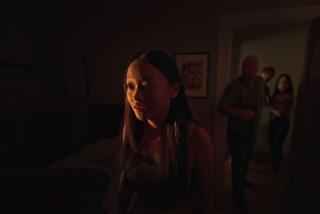MOVIE REVIEW : Shepard’s ‘Tongue’ a Supernatural Western Tale
- Share via
“Silent Tongue” (Beverly Center Cineplex), directed by actor-playwright Sam Shepard, is an alternately infuriating and exhilarating example of the Western as an art film. A stylized allegory of the white man’s brutalization of Native Americans, it’s the kind of picture easily dismissed as pretentious. Richard Harris and Alan Bates, however, are absolutely splendid, indeed possessed of Shakespearean grandeur, as two seemingly very different Irishmen who have sought their fortunes on the American frontier. But their considerable impact is fatally undermined by Shepard’s altogether too theatrical and literal treatment of the supernatural.
A grief-stricken Harris travels over vast expanses in tracking down Bates, the boozy but surprisingly sharp proprietor of a traveling medicine show who’s become hooked on his own product. In the past Harris had purchased from Bates one of his two daughters by the long-departed Kiowa (Tantoo Cardinal) known as Silent Tongue, who had been rendered speechless when her tongue was cut out--a victim of Bates’ rape.
This daughter, Awbonnie (Sheila Tousey), had brought happiness and calm to Harris’ highly--but mysteriously--disturbed son (River Phoenix, in his small next-to-last screen role that asks only that he seem profoundly agitated), but she has died in childbirth, leaving the son so distraught that he cannot bear to bury her corpse, despite the imprecations of her ghost to do so. Harris, beside himself with worry, will pay Bates any amount to sell him his other daughter (Jere Arredondo), although her older half-brother (Dermot Mulrooney) is none too happy about seeing yet another half-sister sold off. Gradually, a drama of revenge against Harris and Bates is set in motion.
As long as Shepard sticks with the tragic Harris and the wily Bates, contrasting examples of the kind of men who exploited Native Americans, “Silent Tongue” is fairly engrossing, although scarcely fresh or original in its anti-white man, pro-Native American stance. The trouble is a great deal of the movie is taken up with the nonstop harangues of Awbonnie’s ghost, who for some reason has had one side of her face disfigured by paralysis and whose deep-voice rage recalls Judith Anderson’s Medea. Tousey might possibly be fine if this were a play instead of a film, but she’s way over the top for the screen. Shepard might better have either presented Awbonnie’s ghost as a silent, accusing figure or let us hear her voice without showing her beyond a wispy, fleeting apparition. In any case, the combination of Awbonnie’s bizarre physical presence and her ceaseless declaiming is too much not to stop the movie dead in its tracks.
This is unfortunate for Shepard, who seems closer in spirit to Leone and Jodorowsky than to Ford. The contributions of cinematographer Jack Conroy, production designer Cary White, costume designer Van Ramsey and composer Patrick O’Hearn couldn’t be more appropriately moody and atmospheric.
“Silent Tongue” has a sophisticated concern for textures and authentic details; this is one Western set in 1873 that doesn’t have 1910 props. In its best moments, Bates’ seedy caravan recalls in its mix of period quaintness and frank sensuality Ingmar Bergman’s tiny traveling circus in “Sawdust and Tinsel.” Ultimately, however, the title of “Silent Tongue” becomes ironic for a movie that talks too much.
‘Silent Tongue’
Richard Harris: Prescott Roe
Sheila Tousey: Awbonnie/Ghost
Alan Bates: Eamon McCree
River Phoenix; Talbot Roe
Dermot Mulroney: Reeves McCree
A Trimark Pictures presentation. Writer-director Sam Shepard. Producers Carolyn Pfeiffer, Ludi Boeken. Executive producers Jacques Fansten, Gene Rosow, Bill Yahraus, Shep Gordon. Cinematographer Jack Conroy. Editor Yahraus. Costumes Van Ramsey. Music Patrick O’Hearn. Production designer Cary White. Art directors Michael Warren, John Frick. Set decorator Barbara Haberecht. Sound Susumu Tokunow. Running time: 1 hour, 41 minutes.
MPAA rating: PG 13, for ghostly terror and some violence. Times guidelines: many intense scenes of brutality toward both men and women, especially the latter.
More to Read
Only good movies
Get the Indie Focus newsletter, Mark Olsen's weekly guide to the world of cinema.
You may occasionally receive promotional content from the Los Angeles Times.








